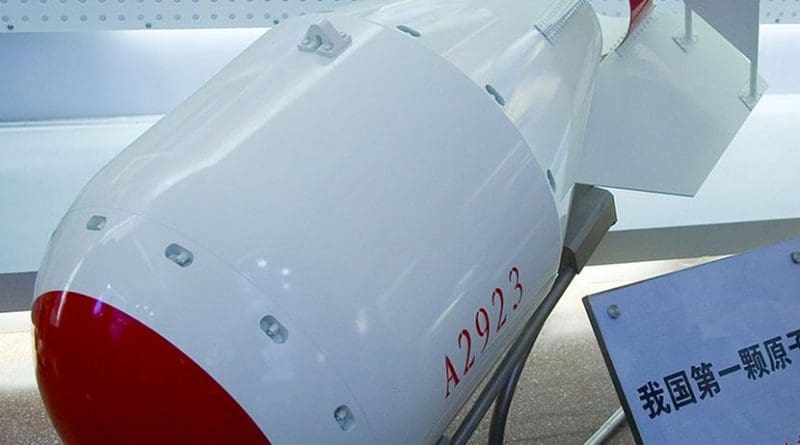China’s Nuclear Program: Modernizing Or Multiplying? – Analysis
By IPCS
By Allyson Rimmer*
China, one of five countries allowed to possess nuclear weapons by the Treaty for the Nonproliferation of Nuclear Weapons (NPT), has been accused of expanding the number of nuclear warheads at its disposal. It is believed to be the only NPT Nuclear Weapon State (NWS) that is doing so. In contrast, some analysts claim that China is not expanding its nuclear arsenal but rather modernising it. If the latter is the case, then there is nothing unique about China’s actions. The US, Russia, France and the UK are all engaging in qualitative upgrades to both warheads and their delivery systems in response to technological advances and changing operational requirements.
Currently, it is estimated that China has a nuclear stockpile of approximately 270 warheads. It is believed by some to be in the process of fabricating more. With such advancements, China’s proliferation pattern is more akin to what other Asian nuclear states (India, Pakistan and North Korea) are doing. Unlike these non-NPT nuclear weapons possessors, China is obligated under the NPT to reduce its nuclear weapons. Accusations concerning China’s expansion, if true, mean that China’s nuclear strategy is in direct conflict with the goals of nuclear abolition. An article published in 2014 by the South China Morning Post claimed that a Chinese military document had announced an increase in the number of warheads in their arsenal, both nuclear and conventional. Other reputable sources – Carnegie Endowment, the Stockholm International Peace Research Institute , Bulletin of Atomic Scientists, and the Nuclear Threat Initiative expressed similar opinions about China’s nuclear weapons, though all contend that accretions to the warhead stockpile are happening at an extremely slow pace. These assertions are based largely on China’s known ability to generate nuclear weapons due to their domestic access to fissile material. Although these claims do have circumstantial basis, they are still inference.
Though the aforementioned sources appear to be confident of China’s vertical proliferation, others hesitate to make such a claim outright. The US government adheres to a more conservative approach. The 2017 Annual Report to Congress pertaining to Chinese security developments discusses China’s shifting nuclear policy, the expansion of such weapons’ delivery systems, and their desire to bolster a nuclear triad to ensure a successful land, air and sea-based nuclear strategy. There is no mention of nuclear warhead expansion, only reference to what equates to nuclear modernisation. Similar assessments conducted by third party experts come to the same conclusion. However, this cautious approach could have more to do with avoiding diplomatic confrontation than with a realistic assessment of nuclear proliferation. The US has a history of underplaying such issues. Throughout the late 1970s, the US willingly turned a blind eye to Pakistan’s development of nuclear weapons in order to focus its attention on Afghanistan, and, therefore, global non-proliferation concerns took a backseat to US Cold War imperatives. Similarly, in the case of present-day China, UN reports accusing the state of facilitating nuclear collaboration between North Korea, Pakistan and Iran have not generated any follow-up. China’s “grandfathering” of nuclear plants in Pakistan, too, has gone uncontested. This denial of the likely increase in Chinese nuclear warheads may be another instance of politics trumping non-proliferation.
Though the conversation is certainly nuanced, there is general agreement surrounding China’s shifting nuclear posture, which focuses aggressively on bolstering its triad capabilities. With its ever-increasing naval presence, China has made it no secret that it plans to alter and strengthen its nuclear doctrine through significant investment in its naval nuclear strike capabilities. China has also dedicated vast resources to the deployment of multiple independently targetable reentry vehicles (MIRVs) in response to advances in US and Indian missile defences. China’s increased naval focus reportedly faces continued setbacks concerning the reliability of its Submarine Launched Ballistic Missiles (SLBM). Despite these technical difficulties, there is little doubt surrounding China’s end goal of reinforcing all facets of its nuclear capability.
In its 2017 White Paper, China reaffirmed its commitment to non-proliferation, conflict de-escalation, and also stressed the importance of Beijing’s continuing role in regional and global efforts towards peace. The state professes, “China…takes an active part in international arms control…non-proliferation efforts, and stands for the complete prohibition and thorough destruction of nuclear weapons.” Considering this statement and the inferential nature of the data surrounding Chinese nuclear expansion, concern over such claims may seem hyperbolic. However, if assertions regarding increased Chinese nuclear warheads are correct, any sense of hyperbole quickly shifts to hypocrisy. Regardless of disagreement regarding vertical proliferation, China is undoubtedly modernising its nuclear arsenal.
*Allyson Rimmer
Research Intern, NSP, IPCS

